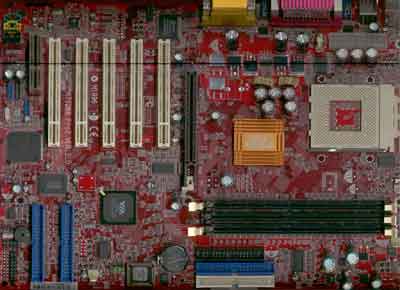VIA KT266A Motherboard Roundup - January 2002
by Mike Andrawes on January 18, 2002 4:48 AM EST- Posted in
- Motherboards
MSI K7T266 Pro2-RU
|
MSI K7T266 Pro2-RU |
|
|
CPU
Interface
|
Socket-A
|
|
Chipset
|
VT
8366A North Bridge
VT 8233 South Bridge |
|
Form
Factor
|
ATX
|
|
Bus
Speeds
|
100
- 164 MHz (1MHz increments)
|
|
Core
Voltages Supported
|
1.725
- 1.850 (in 0.025V increments)
|
|
I/O
Voltages Supported
|
Not
Configurable
|
|
DRAM
Voltages Supported
|
2.5
/ 2.6 / 2.7 V
|
|
Memory
Slots
|
3
184-pin DDR DIMM Slots
|
|
Expansion
Slots
|
1
AGP Slot
5 PCI Slots 1 CNR Slot |
|
Onboard
RAID
|
Promise
PDC20265R
|
|
Onboard
USB 2.0/IEEE-1394
|
NEC
USB 2.0
|
|
Onboard
Audio
|
Avance
Logic ALC201A AC97 CODEC
|
The K7T266 Pro2-RU was one of the first few KT266A boards to hit the market, but it's not the most impressive solution we have seen. The board only has 5 PCI slots, while there is actually space for an extra slot if they are willing to give up the little used CNR slot.
MSI continues to include the Promise PDC20265R IDE RAID controller on the K7T266 Pro2, providing two more channels for either extra IDE connectors or RAID functions.
The most unique feature of the K7T266 Pro2-RU is the on-board USB 2.0 controller that is made by NEC. The K7T266 Pro2-RU has enough on-board headers for a total of 8 USB ports, all of which can be taken advantage of since MSI bundles the appropriate external ports with the motherboard. Of those 8 USB ports, 4 of them are driven by the NEC USB 2.0 controller and can thus be used as regular USB 1.0 ports or they can be used with newer USB 2.0 peripherals thus enabling much higher transfer rates. USB 2.0 peripherals are still scarce so it's up to you as to whether or not this is a true selling point. USB 2.0 support will eventually be integrated into South Bridges, so this is more of an intermediate solution.
The complaints on the K7T266 Pro2-RU all stemmed from MSI's decision to use an AMI BIOS setup with the board. Although the Gigabyte 7VTXH also uses AMI BIOS, its newer version provided more usability for us during testing.
The setup has no pop up menus for quickly selecting from a large list of options. For example, when picking a clock multiplier or FSB frequency you have to scroll through all of the values before getting to the one you want. In contrast, the newer Award BIOSes you can hit the enter key to bring up a popup displaying all of the possible options, sometimes allowing you to input a value manually. The BIOS also lacks the option of disabling Halt on Keyboard errors which was a problem for us since the BIOS kept on reporting a "Keyboard Connected Incorrectly" error, most likely because of our KVM switch box.
The K7T266 Pro2-RU could have been a very nice contender, but what MSI did hardly makes the board one of the best. The choice of AMI BIOS significantly reduces the usability. The choice of NEC USB 2.0 chips does make the board unique, but unless you have any USB 2.0 devices, you would better off searching for another KT266A solution.











3 Comments
View All Comments
Anonymous User - Monday, September 29, 2003 - link
How do I get my Engine to Memory clock to run synchronous for my Epox 8kha+ boardxrror - Saturday, August 14, 2021 - link
This was such an exciting time in PC hardware. Intel was still trying to cram Rambus down the industry's throat - and obstinately trying to strong arm the mobo makers and force chipset makers to Rambus licensing. We still had VIA, SiS, ULi, and even nVidia in the chipset market, and with AMD's Athlon line still extraordinarily competitive and Intel in full attack they could no longer just consider AMD as a side-show - this was their leverage against Intel and they had to treat Socket A as premium platform.NegativeROG - Wednesday, June 15, 2022 - link
I still have this board. AND, I invested all of a $10,000 inheritance in Rambus RDRAM. I'm smarter now (I hope). But, you are right about exciting times in the PC space. I navigated away from AMD for a bit, but came back, and will stay forever. Team RED!